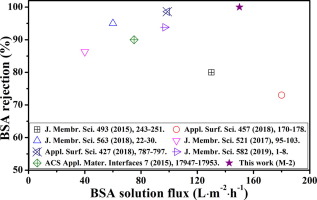Separation and Purification Technology ( IF 8.1 ) Pub Date : 2020-01-18 , DOI: 10.1016/j.seppur.2020.116596 Junqiang Zhao , Qiqi Wang , Jing Yang , Yi Li , Zhongyun Liu , Luqing Zhang , Yiping Zhao , Shuxiang Zhang , Li Chen

|
In order to reduce membrane fouling and fabricate highly selective membranes with high water permeability, three kinds of comb-shaped amphiphilic triblock copolymers, poly[poly(ethylene glycol) methacrylate]-b-poly(methyl methacrylate)-b-poly[poly(ethylene glycol) methacrylate] (PPEGMA-b-PMMA-b-PPEGMA, named as PEME), were synthesized via RAFT polymerization and used as modifiers to prepare poly(vinylidene fluoride) (PVDF) blend membranes by the non-solvent induced phase separation (NIPS) method. The effects of PEME with different hydrophilic PPEGMA length on the surface chemical structure, morphology, permeability and antifouling properties of the blend membranes were investigated detailedly. The results from ATR-FTIR and XPS tests confirmed that hydrophilic PPEGMA segments in PEME were enriched on the membrane surface due to PEME induced surface segregation. With the increase of the hydrophilic chain length in PEME, the mean pore size, porosity and roughness of the blend membrane increased gradually, indicating the modifier had the ability to adjust the membrane pore structure. Compared with pure membrane, the hydrophilicity of blend membranes was enhanced and the protein adsorption of representative bovine serum albumin (BSA) decreased obviously. After three cycles of the water-BSA-water, the M-2 blend membrane exhibited high BSA solution flux (150 L·m-2·h-1), excellent rejection (up to 99.99%) and satisfactory antifouling performance. In addition, compared with the recently published PVDF blend ultrafiltration membranes prepared by NIPS method, the M-2 membrane with surface small pore size, high flux, high selectivity and low fouling properties overcame the permeability-selectivity trade-off for BSA solution separation and showed a good application prospect for efficiently protein separation.
中文翻译:

梳形两亲三嵌段共聚物共混PVDF膜克服了蛋白质分离中的渗透性-选择性折衷
为了减少膜污染并制造出具有高透水性的高选择性膜,我们推出了三种梳状两亲三嵌段共聚物,即聚[聚(甲基丙烯酸乙二醇酯)-b-聚(甲基丙烯酸甲酯)-b-聚[聚(乙二醇)甲基丙烯酸酯](PPEGMA- b -PMMA- b通过RAFT聚合合成-PPEGMA,称为PEME,并用作改性剂,通过非溶剂诱导相分离(NIPS)方法制备聚偏二氟乙烯(PVDF)共混膜。详细研究了不同亲水性PPEGMA长度的PEME对共混膜表面化学结构,形貌,渗透性和防污性能的影响。ATR-FTIR和XPS测试的结果证实,PEME中的亲水性PPEGMA片段由于PEME引起的表面偏析而富集在膜表面上。随着PEME中亲水链长度的增加,共混膜的平均孔径,孔隙率和粗糙度逐渐增大,表明改性剂具有调节膜孔结构的能力。与纯膜相比 混合膜的亲水性增强,代表性牛血清白蛋白(BSA)的蛋白质吸附明显降低。在水-BSA-水的三个循环后,M-2共混膜表现出高的BSA溶液通量(150 L·m-2 ·h -1),优异的拒收率(高达99.99%)和令人满意的防污性能。此外,与最近发布的采用NIPS方法制备的PVDF共混超滤膜相比,具有小孔径,高通量,高选择性和低结垢特性的M-2膜克服了BSA溶液分离和渗透性-选择性之间的权衡问题。展示了有效分离蛋白质的良好应用前景。











































 京公网安备 11010802027423号
京公网安备 11010802027423号